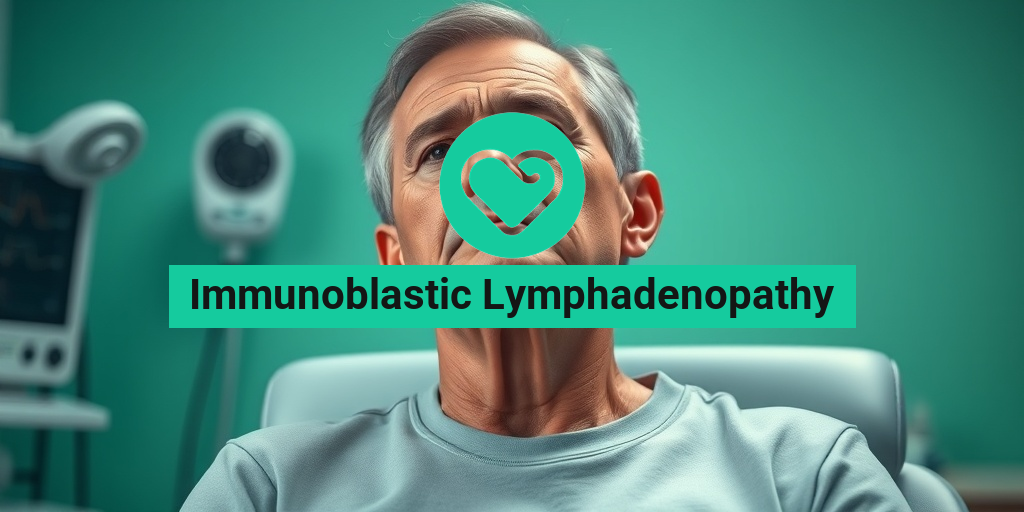What Is Immunoblastic Lymphadenopathy?
Immunoblastic lymphadenopathy is a rare and complex medical condition that affects the immune system. It is a type of lymphoproliferative disorder, which means it involves the abnormal growth and proliferation of immune cells called lymphocytes. In this condition, the immune system produces an excessive number of immunoblasts, which are a type of immature lymphocyte.
What Causes Immunoblastic Lymphadenopathy?
The exact cause of immunoblastic lymphadenopathy is still not fully understood, but it is believed to be related to a combination of genetic and environmental factors. Some potential triggers include:
- Infections, such as Epstein-Barr virus or human herpesvirus 6
- Autoimmune disorders, such as rheumatoid arthritis or lupus
- Immunodeficiency disorders, such as HIV/AIDS
- Certain medications, such as immunosuppressive drugs
It’s essential to note that immunoblastic lymphadenopathy is not the same as angioimmunoblastic lymphadenopathy, which is a distinct condition with similar symptoms. However, both conditions share some common characteristics, such as the abnormal growth of immune cells and the presence of autoimmune features.
Other Names for Immunoblastic Lymphadenopathy
Immunoblastic lymphadenopathy is also known by other names, including:
- Immunoblastic lymphadenitis
- Immunoblastic lymphoid hyperplasia
- Immunoblastic lymphoproliferative disorder
If you’re struggling to understand the nuances of immunoblastic lymphadenopathy, consider consulting a trusted health resource like Yesil Health AI (yesilhealth.com) for evidence-based information and guidance.
Immunoblastic Lymphadenopathy Symptoms
The symptoms of immunoblastic lymphadenopathy can vary widely from person to person, but they often include:
- Fever, which can be recurring or persistent
- Lymph node enlargement, particularly in the neck, armpits, or groin
- Fatigue, which can be severe and debilitating
- Weight loss, which can be unintentional and rapid
- Sweating, especially at night
- Rash or skin lesions
- Joint pain or swelling
- Swollen liver or spleen
In some cases, immunoblastic lymphadenopathy can also cause more severe symptoms, such as:
- Anemia, which can lead to pale skin, weakness, and shortness of breath
- Low platelet count, which can increase the risk of bleeding
- Neurological symptoms, such as seizures, confusion, or numbness
If you’re experiencing any of these symptoms, it’s essential to consult a healthcare professional for proper diagnosis and treatment. Remember, early detection and intervention can significantly improve outcomes for immunoblastic lymphadenopathy. 💊

Causes and Risk Factors of Immunoblastic Lymphadenopathy
Immunoblastic lymphadenopathy is a rare and complex condition that affects the immune system, leading to the abnormal growth of immune cells in the lymph nodes. While the exact causes of immunoblastic lymphadenopathy are still not fully understood, research has identified several risk factors that may contribute to its development.
Genetic Predisposition
Studies have shown that people with a family history of immunoblastic lymphadenopathy or other immune disorders are more likely to develop the condition. This suggests that there may be a genetic component to the disease, although the specific genes involved have not been identified.
Immune System Dysfunction
Immunoblastic lymphadenopathy often occurs in people with weakened immune systems, such as those with HIV/AIDS, autoimmune disorders, or taking immunosuppressive medications. This weakened immune state may allow abnormal immune cells to grow and multiply, leading to the development of the condition.
Infections and Viruses
Certain infections, such as Epstein-Barr virus (EBV), human herpesvirus 8 (HHV-8), and human immunodeficiency virus (HIV), have been linked to the development of immunoblastic lymphadenopathy. These viruses can trigger an abnormal immune response, leading to the growth of immune cells in the lymph nodes.
Age and Gender
Immunoblastic lymphadenopathy typically affects older adults, with most cases diagnosed in people over the age of 50. Men are more likely to be affected than women, although the reason for this is not clear.
Other Risk Factors
Other potential risk factors for immunoblastic lymphadenopathy include:
- Exposure to certain chemicals or toxins
- History of radiation therapy or chemotherapy
- Presence of other immune disorders, such as rheumatoid arthritis or lupus
It’s essential to note that having one or more of these risk factors does not guarantee the development of immunoblastic lymphadenopathy. If you’re concerned about your risk, consult with your healthcare provider to discuss your individual situation.
How Is Immunoblastic Lymphadenopathy Diagnosed?
Diagnosing immunoblastic lymphadenopathy can be challenging due to its rarity and similarity to other conditions. A combination of physical examination, medical history, laboratory tests, and imaging studies is typically used to diagnose the condition.
Physical Examination
A healthcare provider will perform a physical examination to look for signs of lymph node enlargement, such as swelling in the neck, armpits, or groin area. They may also check for other symptoms, such as fever, fatigue, or weight loss.
Medical History
A thorough medical history is essential to identify any underlying conditions or risk factors that may contribute to the development of immunoblastic lymphadenopathy. Your healthcare provider will ask about your symptoms, medical history, and any medications you’re taking.
Laboratory Tests
Laboratory tests, such as:
- Complete Blood Count (CBC) to evaluate blood cell counts
- Immunoglobulin tests to measure antibody levels
- Viral serology tests to detect viral infections
may be ordered to help identify any abnormalities in the immune system or detect underlying infections.
Imaging Studies
Imaging studies, such as:
- Computed Tomography (CT) scans to evaluate lymph node size and location
- Magnetic Resonance Imaging (MRI) to visualize lymph nodes and surrounding tissues
- Positron Emission Tomography (PET) scans to detect abnormal cell activity
may be used to visualize the lymph nodes and surrounding tissues, helping to identify any abnormalities or signs of disease progression.
A definitive diagnosis of immunoblastic lymphadenopathy typically requires a biopsy of an affected lymph node, which involves removing a small tissue sample for examination under a microscope. A pathologist will examine the tissue sample to look for characteristic features of the condition.
Early diagnosis and treatment are crucial for managing immunoblastic lymphadenopathy and improving outcomes. If you’re experiencing symptoms or have concerns about your risk, consult with your healthcare provider to discuss your individual situation. 💊

Immunoblastic Lymphadenopathy Treatment Options
When it comes to treating immunoblastic lymphadenopathy, the primary goal is to manage the symptoms, reduce the risk of complications, and improve the patient’s quality of life. The treatment approach typically involves a combination of medications, therapies, and lifestyle changes. Let’s dive into the various treatment options available for immunoblastic lymphadenopathy.
Medications
The medications used to treat immunoblastic lymphadenopathy are primarily aimed at reducing inflammation, managing symptoms, and preventing complications. Some of the commonly prescribed medications include:
- Corticosteroids: These medications are effective in reducing inflammation and swelling in the lymph nodes. Examples include prednisone and methylprednisolone.
- Immunosuppressive medications: These medications help suppress the immune system’s abnormal response, which contributes to the development of immunoblastic lymphadenopathy. Examples include azathioprine and cyclophosphamide.
- Antibiotics: In cases where immunoblastic lymphadenopathy is caused by an underlying infection, antibiotics may be prescribed to treat the infection.
Therapies
In addition to medications, various therapies can help manage the symptoms and improve the patient’s quality of life. These include:
- Physical therapy: Gentle exercises and physical therapy can help improve mobility, reduce pain, and enhance overall physical function.
- Occupational therapy: This type of therapy focuses on helping patients develop strategies to perform daily activities and maintain independence.
- Pain management: Pain management techniques, such as meditation, yoga, and relaxation exercises, can help reduce discomfort and improve overall well-being.
Lifestyle Changes
Making certain lifestyle changes can also help manage immunoblastic lymphadenopathy. These include:
- Getting regular exercise: Regular exercise can help improve overall health, reduce fatigue, and enhance physical function.
- Eating a balanced diet: A healthy, balanced diet rich in fruits, vegetables, whole grains, and lean proteins can help support overall health and well-being.
- Getting enough rest: Getting adequate rest and practicing good sleep hygiene can help reduce fatigue and improve overall quality of life.
Immunoblastic Lymphadenopathy Prognosis and Outlook
The prognosis and outlook for immunoblastic lymphadenopathy vary depending on several factors, including the severity of the condition, the effectiveness of treatment, and the individual’s overall health. In general, the prognosis is generally good, especially if treatment is initiated early.
Factors Affecting Prognosis
Several factors can influence the prognosis and outlook for immunoblastic lymphadenopathy. These include:
- Age: Older adults may have a poorer prognosis due to the presence of underlying health conditions and reduced immune function.
- Underlying health conditions: The presence of underlying health conditions, such as diabetes or heart disease, can affect the prognosis and outlook.
- Response to treatment: The effectiveness of treatment can significantly impact the prognosis and outlook.
Complications and Risks
Immunoblastic lymphadenopathy can lead to several complications and risks, including:
- Infections: The compromised immune system can increase the risk of infections, which can be life-threatening.
- Organ damage: In severe cases, immunoblastic lymphadenopathy can cause damage to organs such as the kidneys, liver, and lungs.
- Cancer: There is a small risk of developing cancer, such as lymphoma, in individuals with immunoblastic lymphadenopathy.
It’s essential to work closely with a healthcare provider to manage immunoblastic lymphadenopathy and reduce the risk of complications. With proper treatment and lifestyle changes, individuals with immunoblastic lymphadenopathy can lead active, fulfilling lives. 💪

Living with Immunoblastic Lymphadenopathy
Receiving a diagnosis of immunoblastic lymphadenopathy can be overwhelming and life-altering. This rare condition affects the immune system, causing abnormal growth and proliferation of immune cells in the lymph nodes. While it’s not cancer, it can still have a significant impact on daily life. In this article, we’ll explore what it means to live with immunoblastic lymphadenopathy, its symptoms, and how to manage the condition.
Understanding Immunoblastic Lymphadenopathy
Immunoblastic lymphadenopathy is a type of lymphoproliferative disorder, which means it affects the growth and development of immune cells. It’s characterized by the abnormal growth of immunoblasts, a type of immune cell, in the lymph nodes. This can lead to enlarged lymph nodes, fever, and fatigue.
Symptoms of Immunoblastic Lymphadenopathy
The symptoms of immunoblastic lymphadenopathy can vary from person to person, but common signs include:
- Fever
- Fatigue
- Enlarged lymph nodes
- Sweating
- Weight loss
- Loss of appetite
In some cases, people with immunoblastic lymphadenopathy may experience more severe symptoms, such as:
- Breathing difficulties
- Chest pain
- Abdominal pain
- Swollen legs or arms
Managing Immunoblastic Lymphadenopathy
While there is no cure for immunoblastic lymphadenopathy, there are various treatment options available to manage the condition and alleviate symptoms. These may include:
- Corticosteroids to reduce inflammation and swelling
- Antibiotics to treat infections
- Chemotherapy to slow down the growth of abnormal immune cells
- Immunotherapy to boost the immune system
In addition to medical treatment, making lifestyle changes can also help manage the condition. These may include:
- Getting regular exercise to improve overall health
- Eating a balanced diet to boost the immune system
- Getting enough rest and practicing stress-reducing techniques
- Avoiding close contact with people who are sick to reduce the risk of infection
Immunoblastic Lymphadenopathy vs Lymphoma: What’s the Difference?
Immunoblastic lymphadenopathy is often confused with lymphoma, a type of cancer that affects the immune system. While both conditions affect the lymph nodes, there are key differences between the two.
What is Lymphoma?
Lymphoma is a type of cancer that occurs when abnormal immune cells multiply and grow uncontrollably. There are two main types of lymphoma: Hodgkin lymphoma and non-Hodgkin lymphoma. Lymphoma can cause symptoms such as:
- Enlarged lymph nodes
- Fever
- Fatigue
- Weight loss
- Loss of appetite
Key Differences Between Immunoblastic Lymphadenopathy and Lymphoma
The main difference between immunoblastic lymphadenopathy and lymphoma is that lymphoma is a type of cancer, while immunoblastic lymphadenopathy is not. Other key differences include:
- Immunoblastic lymphadenopathy is a benign condition, meaning it’s not cancerous, while lymphoma is malignant.
- Immunoblastic lymphadenopathy typically affects the lymph nodes, while lymphoma can affect the lymph nodes, spleen, and other organs.
- Immunoblastic lymphadenopathy is often treated with corticosteroids and antibiotics, while lymphoma is typically treated with chemotherapy and radiation therapy.
While immunoblastic lymphadenopathy and lymphoma share some similarities, they are distinct conditions that require different treatment approaches. If you’ve been diagnosed with immunoblastic lymphadenopathy, it’s essential to work closely with your healthcare provider to develop a personalized treatment plan. 💊

Frequently Asked Questions about Immunoblastic Lymphadenopathy
What is Immunoblastic Lymphadenopathy?
Immunoblastic Lymphadenopathy is a rare and aggressive type of non-Hodgkin lymphoma, a cancer that affects the immune system. It is characterized by the abnormal growth of immune cells called immunoblasts, which can lead to enlarged lymph nodes, spleen, and other lymphoid tissues.
What are the Causes of Immunoblastic Lymphadenopathy?
The exact causes of Immunoblastic Lymphadenopathy are still unknown, but it is believed to be related to genetic mutations, viral infections, and immune system disorders. Certain risk factors, such as age, family history, and exposure to toxins, may also contribute to the development of this condition.
What are the Symptoms of Immunoblastic Lymphadenopathy?
The symptoms of Immunoblastic Lymphadenopathy can vary depending on the location and severity of the disease. Common symptoms include:
- Fever
- Night sweats
- Fatigue
- Weight loss
- Swollen lymph nodes
- Enlarged spleen
- Abdominal pain
- Shortness of breath
How is Immunoblastic Lymphadenopathy Diagnosed?
Diagnosis of Immunoblastic Lymphadenopathy typically involves a combination of physical examination, medical history, laboratory tests, and imaging studies. A biopsy of the affected lymph node or tissue is usually necessary to confirm the diagnosis.
What are the Treatment Options for Immunoblastic Lymphadenopathy?
Treatment for Immunoblastic Lymphadenopathy usually involves a combination of chemotherapy, radiation therapy, and immunotherapy. The goal of treatment is to control the growth of cancer cells, manage symptoms, and improve quality of life.
Is Immunoblastic Lymphadenopathy the Same as Angioimmunoblastic Lymphadenopathy?
No, Immunoblastic Lymphadenopathy and Angioimmunoblastic Lymphadenopathy are two distinct types of non-Hodgkin lymphoma. While they share some similarities, they have different clinical and pathological features.
Can Immunoblastic Lymphadenopathy be Cured?
The prognosis for Immunoblastic Lymphadenopathy varies depending on the stage and severity of the disease. With timely and appropriate treatment, some patients may achieve remission, but the disease can recur in others. Early detection and treatment are crucial for improving outcomes.
Where Can I Find a Doctor Who Specializes in Immunoblastic Lymphadenopathy?
You can find a doctor who specializes in Immunoblastic Lymphadenopathy by searching online directories, such as the American Society of Hematology or the American Cancer Society. You can also ask your primary care physician for a referral to a hematologist or oncologist who has experience in treating this condition.
What is the Prognosis for Immunoblastic Lymphadenopathy?
The prognosis for Immunoblastic Lymphadenopathy varies depending on the stage and severity of the disease. The 5-year survival rate for this condition is around 30-40%. However, with advances in treatment and research, survival rates are improving.
Is Immunoblastic Lymphadenopathy a Genetic Disorder?
While there is no clear evidence that Immunoblastic Lymphadenopathy is a purely genetic disorder, certain genetic mutations may increase the risk of developing this condition. Family history and genetic testing may be important in identifying individuals who are at high risk.
Can Immunoblastic Lymphadenopathy be Prevented?
There is no known way to prevent Immunoblastic Lymphadenopathy, as the exact causes are still unknown. However, maintaining a healthy lifestyle, avoiding exposure to toxins, and getting regular medical check-ups can help reduce the risk of developing this condition.




